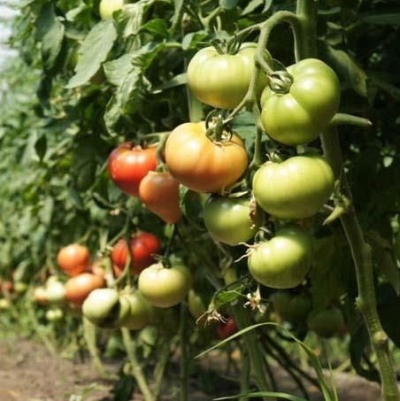
- Authors: Sakata Vegetables Europe S.A.S.
- Year of approval: 2015
- Name synonyms: Pink Magic
- Category: hybrid
- Growth type: indeterminate
- Appointment: fresh consumption
- Ripening period: mid-early
- Ripening time, days: 100-120
- Growing conditions: for film greenhouses, for greenhouses
- Marketability: high
The Pink Magic tomato is a rather interesting variety of European selection. The beautiful name (translated from English - "pink magic") attracts more and more gardeners from all over the country to it. The variety is fruitful, but not suitable for beginners.
Breeding history
Pink Magic was bred by Sakata Vegetables Europe S. A. S. The original name of the variety is Pink Magic. The plant was included in the State Register in 2015, which means that the variety is still relatively new and not entirely common.
Description of the variety
Pink Magic is a tall hybrid tomato with indeterminate bushes. Plants reach a height of 200 centimeters, but it also happens that they stretch even more. Vigorous shrub specimens with abundant medium-sized foliage. The color is normal, green, classic for nightshades.
The main qualities of the fruit
Unripe Pink Magic berries are no different from the color of other varieties in the unripe stage - they are green. Ripening, the fruits acquire a pink color, which is the reason for the name of the variety. Tomatoes are large, round, ribbing is rather weak. The dense, tender and fleshy pulp is covered with a thin skin, casting a glossy sheen. Despite the apparent fragility, it is very elastic, protects tomatoes from cracking. That is why the marketability and transportability of this variety are at a high level. The berries weigh 208-239 grams.
Taste characteristics
Pink Magic tastes excellent. Those who have already tried growing the variety claim the sweetness of the fruit without a hint of sourness. Tomatoes are mostly eaten fresh or put up for sale, but winter and other harvests can also be made from them.
Ripening and fruiting
Pink Magic is a classic representative of mid-early varieties. It ripens in 100-120 days. Harvesting dates are July and August.
Yield
Both originators and gardeners claim a high yield of the hybrid. It is quite possible to collect 26.7-29.7 kilograms of ripe berries from a square meter of soil. At the same time, the yield of marketable fruits is 94.5%.
The timing of planting seedlings and planting in the ground
The Pink Magic hybrid variety is grown exclusively by the seedling method. It is important to remember that you will have to buy seeds every time, since a hybrid of seed does not give. Seeds are sown in late February or early March, focusing on the weather conditions and climate in the region. Planting boxes, as well as seeds, must be disinfected. It will not be superfluous to soak them in a growth stimulator.
The soil must be fertile and nutritious. Pink Magic will only grow well in light and loose substrates. The easiest way is to buy ready-made soil, but if you prepare it yourself, then the soil will need to be calcined. The seeds are buried in already moistened soil and sprinkled with soil a little. In order for plants to grow healthy, you need to follow a few rules:
maintain the parameters of humidity and temperature at the desired level;
provide long daylight hours;
irrigate seedlings from a spray bottle;
ventilate regularly;
dive after the appearance of two sheets;
temper.
If you adhere to these recommendations, then the seedlings will be ready for planting in late April or early May. Young shoots should be planted in closed ground or under a film shelter.

Growing tomato seedlings is an extremely important process, because it largely depends on whether the gardener will be able to harvest at all. All aspects must be taken into account, from seedbed preparation to planting in the ground.
Landing scheme
Pink Magic bushes need enough space to grow optimally. For this, a maximum of 4 plants are placed on 1 square meter. But even that might be too much. Those growers who have already cultivated a hybrid argue that it is better to plant only two bushes. The recommended landing pattern is 40x60 centimeters.

Growing and care
Pink Magic tomatoes are in dire need of light. If it is not enough, the ovaries will begin to form poorly. Therefore, with a lack of sunlight, you will have to take care of purchasing phytolamps for supplemental lighting.
Tomatoes of this variety are very tall. Therefore, they must be formed without fail. This is done in 1 stem, the top must be pinched, otherwise the plant will continue to stretch upward.
In addition, pinching will be an important point. The stepsons take away the strength from the plant, the yield is less than expected. They are cut off early in the morning or in cloudy weather, the wounds must be treated. Try to pinch so that a small stump remains in the place of the offshoot. Then the next lateral stem will not appear soon.
Other care activities will be as follows:
watering is carried out once a week (exceptions are drought and flowering);
loosening and weeding is carried out after each watering;
dressings alternate with each other (mineral and organic);
the plant must be tied up in order to avoid breakage of the bush;
carry out preventive treatments with fungicides and insecticides;
regularly ventilate the greenhouse.
Resistant to extreme weather conditions
Pink Magic is an excellent variety in terms of hardiness. It perfectly resists:
cold;
heat;
drought;
shadows.
However, it is still not recommended to abuse the abilities of the tomato.




A plant needs different micronutrients at each stage of growth. All fertilizers can be divided into two groups: mineral and organic.Folk remedies are often used: iodine, yeast, bird droppings, eggshells.
It is important to observe the rate and period of feeding. This also applies to folk remedies and organic fertilizers.



























































































